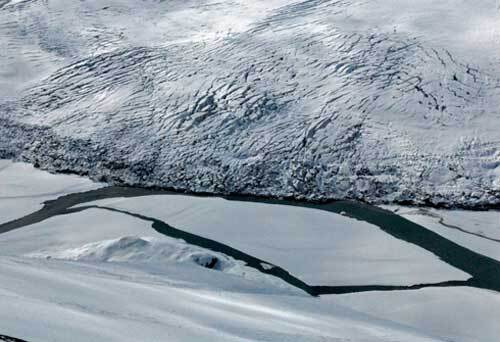

Bad desert air and a glacier that licks a river
Cathy Cahill got a package in the mail last week from a desert on the other side of the world. She didn’t know what was inside, but she hoped it was air samples from Baghdad. When she opened the package, she didn’t believe her eyes.
"I’ve never seen that much dust (on a slide used for air sampling),” she said. “There’s so much that it’s flaking off.”
Cahill, who works at the Geophysical Institute at UAF, studies air quality in Alaska and all over the world. In November, Pam Clark of the Army Research Lab in Adelphi, Maryland, asked Cahill if she could deploy a few air samplers at Army camps in Iraq, as part of an Army program to study the air in places where military members are stationed. Cahill enlisted a few soldiers to help her, and she is now sampling the air around the clock at two sites in Baghdad.
Her first batch of samples came to Alaska in the form of eight transparent slides that captured things floating in the air. The slides fit inside an instrument that uses a pump to suck in air and trap different-size particles on different slides. The slides she received are all filthy, from coarse reddish-yellow dust to fine black material.
“The black is usually diesel from generators, trucks, and other stuff along those lines, Cahill said. Most of the sizes (of particles) I’m dealing with here are things that get in people’s lungs.”
Cahill was preparing to send some of the samples on her desk to the University of Arizona in Tucson so that scientists can look for biological material in the air that soldiers are breathing in Baghdad. She said sands often carry with them fungi and bacteria that can make people ill. She will also send a portion of the samples to Lawrence Berkeley National Laboratory in California to see the precise composition of the gunk on the slides. From her initial samples, Cahill thinks she can tell the days when dust storms struck.
“Looking at the color of the strips, they look an awful lot like the air I’ve seen from Beijing,” she said. “They don’t look like anything we’d get in Alaska.”
Cahill has set out the same air samplers near Augustine Volcano, in Cook Inlet, and at Poker Flat Research Range, and she’s grateful for the chance to put her expertise to work in Iraq.
“This is a case where I can do something that’s important,” she said. “These are my neighbors (from Fort Wainwright in Fairbanks) that are over there. If I can get baseline information, we can figure out what we can do to help them.”
***
Last week, Chris Larsen of the Geophysical Institute went out and checked on the surging Tweedsmuir Glacier, which has dipped its toe in the Alsek River in northern British Columbia. With Paul Klaus of Ultima Thule Outfitters flying him, Larsen took some photos of the glacier, some of which he posted at http://fairweather.gps.alaska.edu/chris/. The glacier has advanced 1,200 meters from August 2007 until now. If it advances 350 more meters, the glacier will hit a knob of bedrock on the far side of the river and will block it, at least temporarily. The Alsek flows into Alaska and then into the north Pacific at Dry Bay.
“At this stage, there will be some good icebergs in the river,” Larsen said, noting that the glacier is surging into the river at the upstream end of narrow Turnback Canyon, which means the glacier could dam the river, which would someday eat through the glacier in an awesome outburst flood. “It’s going to be a spectacular show regardless of what happens.”






